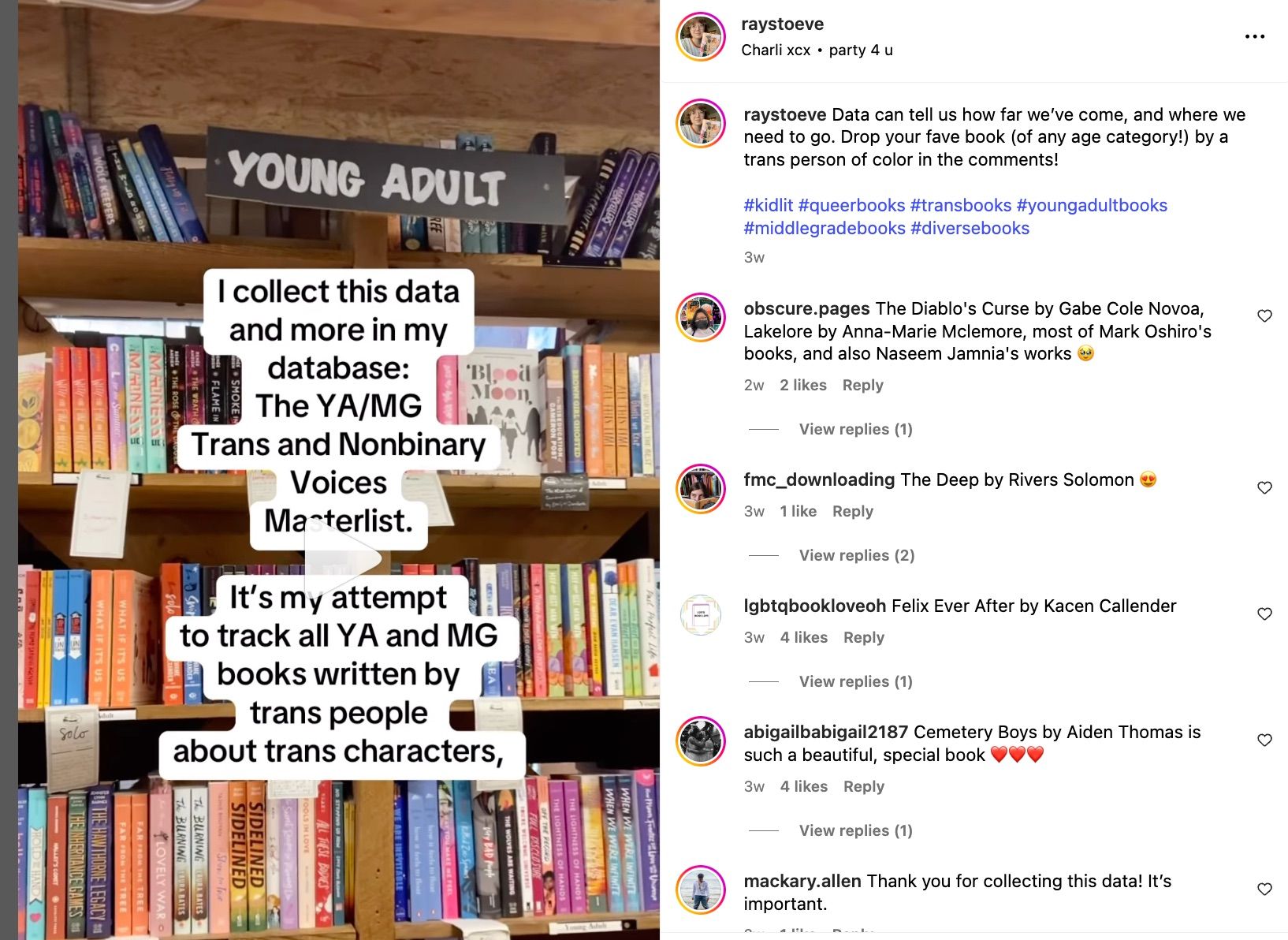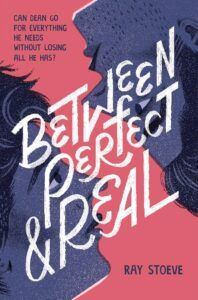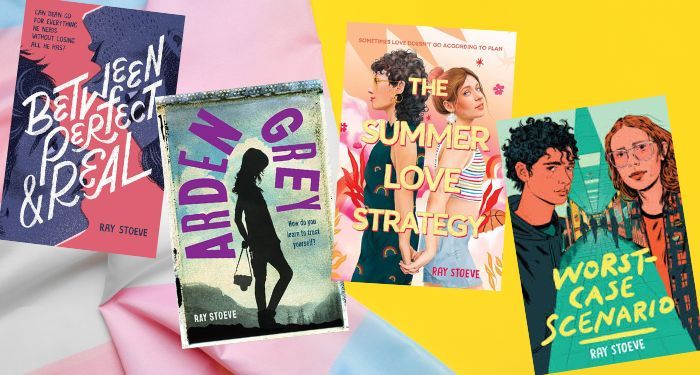This content contains affiliate links. When you buy through these links, we may earn an affiliate commission.
Last month, I was scrolling on Instagram when a video caught my eye. The creator was in a bookstore–later identified as Elliott Bay Books– and highlighting the growth in trans and nonbinary YA books over the last several years.
I kicked myself for not saving the video, as I knew it would be the kind of thing I wanted to spotlight here. The good news is that the moment I asked on my own Instagram feed if anyone knew what video I was talking about, I got nearly a dozen responses.
Meet Ray Stoeve, YA author of several books, including The Summer Love Strategy, Arden Grey, and Between Perfect and Real. They were the mind behind the video, which sprung out of their incredible work developing and maintaining the YA/MG Trans and Nonbinary Voices Masterlist. This database tracks the offerings each year centering trans authors and trans voices.

I’m honored to have Ray here to talk about the database, some of the highlights and lowlights in representation over the years, and some of their favorite trans and nonbinary YA titles that all readers should get their hands on ASAP.
***
In Fall 2019, I got a text from a friend asking if I had any recommendations for YA novels featuring trans characters written by trans people. She’d just finished reading If I Was Your Girl by Meredith Russo, and she wanted more. I was a YA author, and active in the YA community, but I could only think of one title: I Wish You All The Best by Mason Deaver, which had come out earlier that year.
That didn’t seem right. There had to be more than two trans YA titles, I thought. I’d seen various lists and databases circulating on social media at the time, such as The Asexual and Aromantic Characters Database by Claudie Arsenault and LGBTQReads by Dahlia Adler, and Malinda Lo’s work to count LGBTQ+ YA titles. So I decided to create my own database.
That project became The YA/MG Trans and Nonbinary Voices Masterlist. As I scoured the Internet for trans YA novels, my interest expanded beyond simply cataloging titles. I wanted it to be a tool not only for readers to find books, but for everyone to learn more about how trans representation in YA novels was developing over time. Maybe, I thought, it could even help hold publishers accountable to diversifying their acquisitions and supporting their trans authors. So, as I tracked book and author names, I also tracked other data points: publishing house, publication year, character identity markers such as gender, race, and sexual orientation, and more.
There were more than two titles. In January 2020, when the Masterlist went live for all to access, I’d recorded 33 trans YA novels published since 2013 by both the Big 5 and independent houses. That included titles already published, and ones forthcoming in 2020 and 2021.

The Masterlist has grown from there. In 2021, we had what I affectionately call the Trans YA Boom Year, with the most titles published in a year at that point: 19, including my own debut, Between Perfect and Real, about a closeted trans boy whose coming out and transition is sparked when he’s cast as Romeo in the school play. Today, there are 119 traditionally published YA novels, 95 of them where the character is the protagonist, written by trans authors and featuring trans characters on the Masterlist. I also track characters in secondary roles as well as in middle-grade books. Readers have used it to find the stories they want, booksellers and librarians have used it to build their shelves, and PhD students have used it for their dissertations.
It’s incredibly exciting to see the reach the Masterlist has had, the impact it’s made, and the way it’s grown over the years. However, I remain concerned about the lack of diversity within trans YA acquisitions. As I shared recently on social media, racial representation of protagonists in trans YA has remained roughly the same over the five years I’ve been tracking it. In 2020, the split was 82% White characters, 18% characters of color. HarperCollins led the pack, with seven total titles, only one by a trans author of color about a trans character of color. Macmillan and Penguin Random House followed, with more even splits. At that time, according to my data, Hachette and Simon & Schuster hadn’t published any trans YA titles. Independent houses weren’t doing any better, with seventeen titles and only one of them featuring a trans character of color.
My most recent count in 2024 shows a very similar split in racial representation of trans protagonists in YA across all the houses. The numbers have tripled in size, but the percentage is 78% White characters, 21% characters of color. This maps onto the statistics for authorial representation as well, meaning the number of trans authors of color picked up by YA publishing remains around 20% over five years.
The lag is similar for gender representation. Of the 95 titles with trans protagonists on the Masterlist, only 11 of those titles feature trans girls or trans femmes. 38 feature trans boys and transmasculine characters; 24 feature nonbinary characters. The remaining titles are much smaller splits between agender, bigender, demigirl, demiboy, genderqueer, and gender fluid characters. There are no two-spirit characters on the list.
While The Masterlist is not exhaustive, as it relies on just me and my free time to keep up with adding titles, these numbers show how trans YA is a microcosm of ongoing disparities in children’s literature. As books by and about marginalized people, particularly queer and trans people and people of color, face an increasing push for bans, and our lives and identities continue to be targets for erasure and eradication, we should all keep a close eye on how the decision-makers at the top in publishing houses are responding.

In the meantime, I am buoyed by the boundless creativity, imagination, talent, and perseverance of my fellow trans writers, past and present. We are holding sacred ground for all who come after us. That’s one of the reasons I write trans characters into all my books. I want the teens (and adults!) who read them to walk away feeling, hopefully, a little more seen in some way. I know that our stories make an impact because of the readers who have told me that my books helped them come out to themselves or their loved ones, made them laugh or cry (let’s be real, it’s usually both when it comes to my books), or gave them a way to process and even celebrate their own experiences. Between Perfect and Real has particularly struck that chord with trans folks of all ages.
My second book, Arden Grey, is about a queer girl coming to terms with her dysfunctional parents’ divorce and healing from her mother’s emotional abuse, while also questioning whether she’s asexual. My third, The Summer Love Strategy, is a rom-com about two neurodivergent sapphic besties who make a step-by-step plan to find their first girlfriends. My fourth, Worst-Case Scenario, comes out on January 20, 2026. It’s a romance about a nonbinary teen with undiagnosed OCD who has to share the presidency of their school’s Queer Alliance with their nemesis, only to find out working together is actually kind of…nice?
Here are five titles I recommend from the past five years:
Happy reading, and happy Pride!
The following comes to you from the Editorial Desk.
This week, we’re highlighting a post that asks: Are reading parties the next big thing? People—especially readers—are clearly looking for community. Are reading parties the answer? Read on for an excerpt and become an All Access member to unlock the full post.
Reading communities are everywhere online. From Storygraph to Fable to BookTube to BookTok, the growth of online reading buddies feels exponential. The problem with social media as it exists online, however, is that it’s a stand-in for the true connections we all seek over the things we love. As much as reading roundups and reading tracking can be fun, meeting up with in-person book lovers is a great book lover community event. With that in mind, reading parties could be the next big thing.
A reading party is distinct from a book club because everyone shows up to read instead of having read something to discuss. At a reading party, you can make time to discuss what you are reading, but it doesn’t all need to be the same book. It’s more of a reading vibe check than a book discussion.
Sign up to become an All Access member for only $6/month and then click here to read the full, unlocked article. Level up your reading life with All Access membership and explore a full library of exclusive bonus content, including must-reads, deep dives, and reading challenge recommendations.